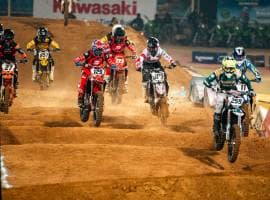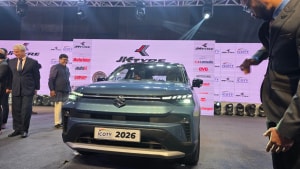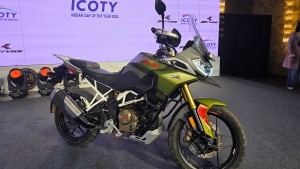24 Hours of Le Mans 2016: 'The weekend that was' for Porsche
One man's weekend of intense racing is another man's weekend of intense merrymaking. It's this thought that crosses my mind as I'm standing in line to buy a ticket for a ride on Le Man's famous ferris wheel that all-seeing eye that looks over everything that happens at the Circuit de la Sarthe. For, while I'm standing there surrounded by a crowd of people also clamouring to get onto what is essentially an amusement park ride, the big race is continuing out on track.
This particular part of the Circuit de la Sarthe is a far cry from the tense faces of race engineers and mechanics that you see standing on the pitwall gazing anxiously out at the track. In fact, if you block out the sound of the cars, it would be nearly impossible to tell that you are at the races at all, what with all the laughter, shouting and general merrymaking that abounds. Here, the fans are happy, if somewhat inebriated (some strapping gentlemen tumbled past me clad in summer dresses and wigs), and seemingly only interested in having a rollicking time.
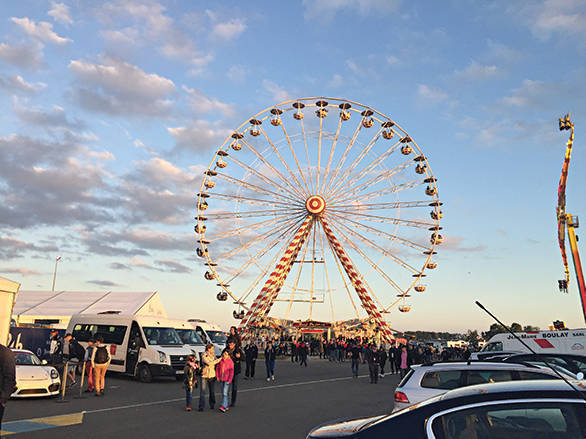 Le Mans' famed ferris wheel that overlooks Ford Chicane and has plenty of activity around it all through the race
Le Mans' famed ferris wheel that overlooks Ford Chicane and has plenty of activity around it all through the race
Once on the ferris wheel though, especially when it's at its zenith, I'm reminded once again that I'm most definitely at a motorsport event. I can see the racecars as they come barreling down Ford Chicane and head onto the start-finish straight. I can see the packed grandstands from a distance. I can see various hospitality buildings with people nearly spilling off balconies to catch a sight of the cars going by. And it appears no matter which way I crane my neck, there's an endless sea of camper vans and cars a clear indicator of those 263,500 people I later learn were in attendance at the big, big race.
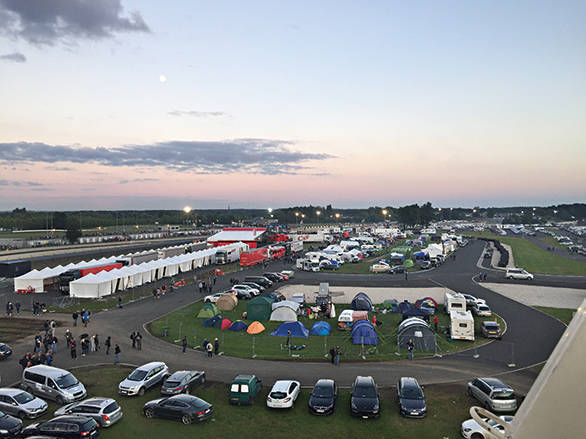 Camper vans as far as the eyes can see from the ferris wheel
Camper vans as far as the eyes can see from the ferris wheel
Let's not forget though with a big, big race, comes big, big pressure.
I had managed to catch a glimpse of said pressure at the pre-race press conference hosted by Porsche on the Friday before the race. There were mixed emotions within the Porsche camp. The previous day, during qualifying, the No. 2 Porsche 919 Hybrid, with Neel Jani at the wheel, had blazed its way to pole position with a time of 3min 19.733sec. Second spot on the grid went to the No.1 919 Hybrid. With the two Toyota TS050s and two Audi R18s following. In the LMP1 category, it was clear that Porsche had thrown down the gauntlet and was all set to pursue a historic 18th win at the Circuit de la Sarthe. But things weren't going quite according to plan in the GTE Pro category, with the Ford GTs and Ferrari 458 Italias ahead of the Porsches 911s, the first of which had qualified eighth in class. How had this happened, though? Sandbagging. Possibly the oldest trick in the Balance of Performance (BoP) book.
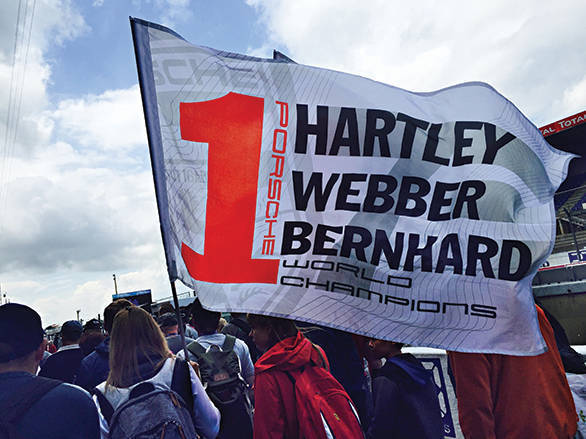 Big support for defending WEC champions Hartley, Webber and Bernhard
Big support for defending WEC champions Hartley, Webber and Bernhard
Nobody who attended the press conference that day could forget what happened. One minute the atmosphere was hopeful, with the focus being on the LMP1 car that was on pole. The next minute, Dr Frank-Steffen Walliser, the Head of Porsche Motorsport, was having trouble holding back his tears. He'd been asked a question about Balance of Performance that all important grid-equalising measure that allows Porsche 911s to compete against Aston Martin Vantages and Chevrolet Corvette C7Rs and the new Ford GTs. He'd gotten as far as saying, "We all know we need BoP it's important and relevant for the sport. It enables GT racing... But we do not need this kind of BoP." Then, he broke down. It was an illustration of just how competitive and frustrating motorsport can be. Particularly for teams who have worked hard and played by the rules, only to have their hard work negated by teams who possibly haven't.
Walliser wasn't the only one who felt this way about the BoP fiasco. Several other drivers did too, including Dempsey Proton Racing's Phillip Eng who I encountered sauntering through the paddock. "Do you think something will be done about the BoP penalties before the race?" I'd asked him. "I think they'll have to do something!" he'd exclaimed. "Nobody is happy about it. They'll have to do something," he shook his head before dashing off to do get ready for the Le Mans parade that takes place in the city centre.
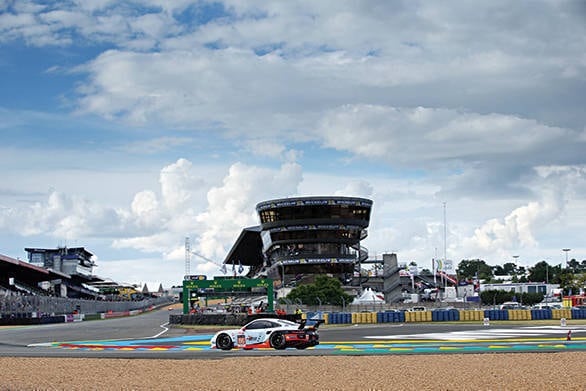 Quieter times for the Gulf Racing 911 GTE Am team you see here
Quieter times for the Gulf Racing 911 GTE Am team you see here
Outside of the Porsche press conference area, Le Mans looked the way Le Mans ought to look. After all, it was Mad Friday. Fans were enjoying the freedom to walk down the pit lane and onto the grid, only needing to take care not to step in the gravel traps on either side of the track. Those who ignored the fact that you weren't meant to traipse through the neatly raked gravel had to incur the wrath of a whistle-blowing marshal. Other fans wandered around with flags in support of their favourite teams and drivers. I spotted one banner hanging over the grandstands in support of Le Mans favourites Andre Lotterer, Benoit Treluyer, Marcel Fassler and their race engineer Leena Gade. There was another set of fans wandering around in support of the No.1 Porsche of Mark Webber, Brendon Hartley and Timo Bernhard. In fact, the more I looked, the more evident it became that there was a lot of support for the Porsche team. After all, with 17 wins at Le Mans in the bag, and in hot pursuit of an 18th win, they were the race's winningest manufacturer.
But what is Le Mans if not a race of contrasts? On the one end of the spectrum was Porsche's LMP1 team. The team who had started to prepare for their return as far back as 2012, and had announced to the world their intent to return when they broadcast "Mission 2014: Coming home". And, after a quiet return upon their homecoming, they had managed to win the race in 2015 with drivers Nico Hulkenberg, Earl Bamber and Nick Tandy. On the other end of the Porsche spectrum was the Gulf Racing UK team, with their orange and blue No.86 GTE Am 911. Unlike the big boys over at the factory team, all of whom were committed to motorsport and motorsport alone every single day, the GTE Am team was very, very different your typical small team with big hearts! In fact, the assistant team principal, Owen Daley, laughingly mentioned the day before the race that he actually worked in IT. "Oh, this is just a hobby. I'm usually behind my computer when I'm not sitting at the pitwall!" he said. It's a high-level hobby though, which meant that the team and their drivers Mike Wainwright, Adam Carroll and Ben Barker really did want a good result at their first-ever attempt at the 24 Hours of Le Mans. They hadn't managed to land a slot in the 2015 edition of the event. And Daley said he'd be happy if they managed to get through the first 12 hours of the event.
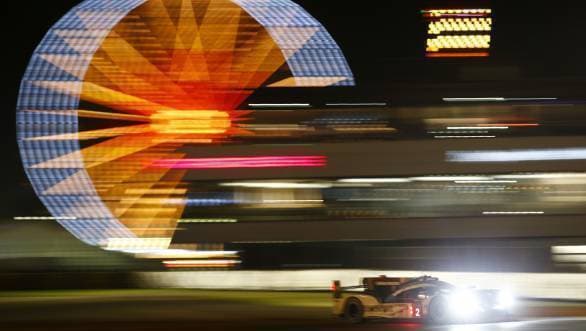 The 2016 24 Hours of Le Mans winning No.2 Porsche 919 Hybrid
The 2016 24 Hours of Le Mans winning No.2 Porsche 919 Hybrid
Back to the other side of the spectrum, then. At the Porsche press con, I'd managed to fight through a crowd of eager journalists and have a chat with three of their LMP1 drivers. And front row lock out of the grid or not, none of them were willing to take Porsche's pace for granted. Nor were they willing to underestimate their rivals. "Last year Toyota wasn't really in the reckoning, but this year they are. The LMP1s are pretty evenly matched. And I'm not just saying that for the press. It's genuinely a close field," Brendon Hartley, driver of the No.1 Porsche 919 Hybrid had said. His team-mate Timo Bernhard, the man who was a part of Porsche's Le Mans return from the very beginning, "from the mock-ups for seat position and switches" said that the pressure was different. "In 2014 we came in with no expectations and we almost had a podium. In 2015 we showed we could do it. So it's different. The expectations are greater," he'd said.
Pole man Neel Jani, who was sharing the No.2 Porsche 919 Hybrid with Romain Dumas and Marc Lieb, spoke of other concerns. Namely, the weather. "Visibility can be an issue. Not only because of the rain, but when the rain stops and the track starts to dry, there's a heavy fog that hampers our vision," he'd said. Jani had also said that he believed the most critical part of the race was going to be right at the beginning. "If it's wet at the start, it could be very tricky because it's so easy to get taken out. We need to survive the first two or three hours," he'd said.
As it turned out the following day, Jani had been right to be concerned about a rain-soaked start to the race. The clouds were slowly but surely gathering over the track as the clock ticked closer to the race's 3pm flag-off time. And, as expected, the skies opened up and rain poured down all over the 13km long track. The race began behind the Safety Car, as water collected at various parts of the circuit. The fans brought out their umbrellas and donned rain gear and gumboots. The rain and the Safety Car had resulted in dampened spirits and soaked-through bodies too. But when the Safety Car finally did peel off into the pits, which signalled the beginning of proper racing, the crowd let out an almighty roar. After all, it was proper, good, old-fashioned racing that they were there to see!
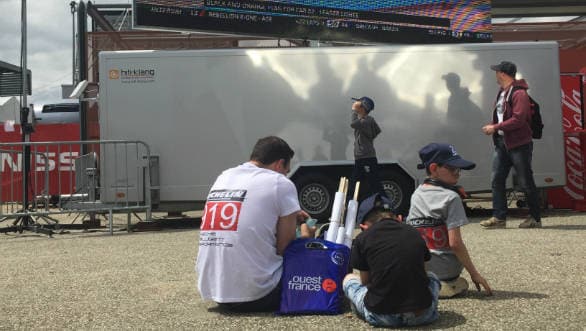 Porsche fans seem subdued towards the end of the race as it really does look like a Toyota victory is on the cards
Porsche fans seem subdued towards the end of the race as it really does look like a Toyota victory is on the cards
As the race wore on and the circuit dried up, fans began to wander from one part of the circuit to the other, catching glimpses of their favourite cars from various spots on the track. I even saw one group of particularly clever people who had simply assembled their own portable grandstands somewhere near the Porsche Curves, giving them a terrific vantage point from which to view the race! The fans were running about, fuelled no doubt by that Le Mans delicacy rillettes de canard, which is a duck meat pate that I highly recommend to everyone who visits the race, despite the fact that my German travelling companion dismissed it as being "just entenpastete", which is apparently available all over Germany. Meanwhile, the mechanics and race crew were running on adrenaline faces in the pit lane and garage were already tired and tense. In fact, Neel Jani'd said that Le Mans week is so exhausting that the only peace he gets is a long stint of driving during the race!
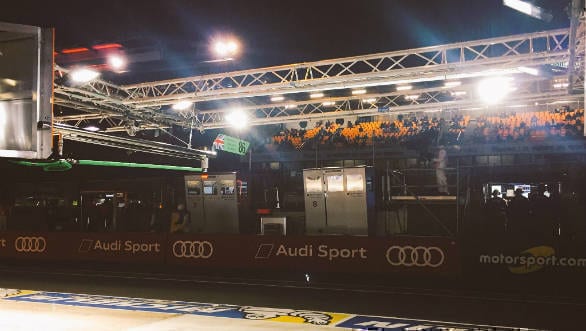 Midnight hour approaches and the teams are thoroughly busy with strategy - Le Mans means no rest for anyone!
Midnight hour approaches and the teams are thoroughly busy with strategy - Le Mans means no rest for anyone!
Within the Porsche camp, though, there was good reason to be tense. The Toyota TS050s were proving to be more frugal and gentle on the tyres than their own LMP1 cars. While the Toyotas fell into a rhythm of 14 laps a tank, the Porsches could only do 13 laps a tank. It seemed more and more obvious that the race was slowly slipping into the hands of the Japanese team. The team that had never managed to win at the 24 Hours of Le Mans but had hankered after a win at the big race for years and years.
There were more reasons for the drawn faces at Porsche though. The No.91 GTE Pro Porsche had its radiator punctured by a rock, which led to an engine failure. The No.92 Porsche retired with a broken front right suspension. At least they'd done what Dr Walliser had promised they'd do "We will fight. We will fight," he'd said at the press conference. And fight they had, which did little to change the outcome of the race that pesky Ford GT would eventually win anyway!
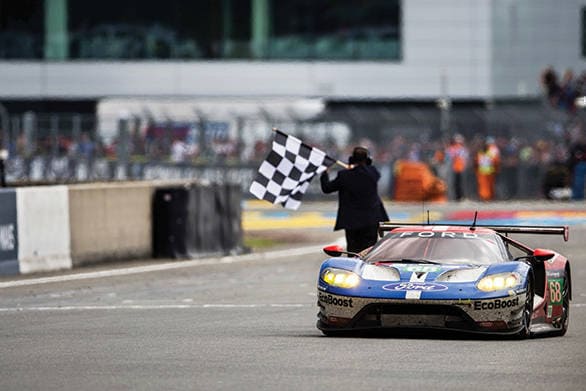 The No.68 Ford GT that won the GTE Pro Class, amidst plenty of BoP controversy
The No.68 Ford GT that won the GTE Pro Class, amidst plenty of BoP controversy
A midnight saunter through the paddock was proof enough that nothing ever comes to a standstill at the 24 Hours of Le Mans. The garages were in full swing, with mechanics busily cleaning out old tyres, race engineers staring bleary-eyed at computer screens and drivers getting ready for their stints in the car. It was busy and calm all at once. In fact, the Gulf Racing UK team had a bunch of smiling but sleepy mechanics, all of whom were relieved that their car had been in no trouble up until that point in the race. After all, as the race was heading towards the 12-hour mark, things were settling down into something of a rhythm. There was a sense clockwork precision that had set in on track at the Circuit de la Sarthe. Off track, however, the music was getting louder, the fans drunker and the partying more intense.
Jani had told us that the Sunday morning of the race would be critical. It was, he'd said, the time when all the teams would need to take stock of their situations and see whether or not they ought to continue at the pace at which they had been going. Or if they needed to push. Since it appeared to be Toyota's race to lose, the Porsche team needed to push as much as possible until the chequered flag fell.
So it came to pass that in the final hour of the race, the No.2 Porsche needed to pit to change all four tyres. This meant that unless disaster struck, Kazuki Nakajima was home free and about to give Toyota their first-ever win in the 18th year that they'd taken part at Le Mans. The faces in the Toyota garage were looking quietly confident. Outside the Porsche fans looked disconsolate. Then things all changed. With just six minutes to go in the race, Nakajima began to slow down. And by some cruel twist of fate, he came to a halt just after the start-finish line. There was still one lap left in the race, and Jani's Porsche had swept past him.
 Romain Dumas, Marc Lieb and Neel Jani celebrate their victory at Le Mans
Romain Dumas, Marc Lieb and Neel Jani celebrate their victory at Le Mans
It was a study in opposites, it was. In the Porsche garage, Mark Webber's jaw dropped open. Jani's co-drivers Lieb and Dumas looked shocked, burst out laughing and crying all at once. Three minutes stood between them and victory. Suddenly the silence was gone. Outside, Porsche fans were whooping and cheering. I heard a shocked voice yelling "Unglaublich!" German for "unbelievable." In stark contrast, the otherwise chatty media centre was enveloped in a stunned silence.
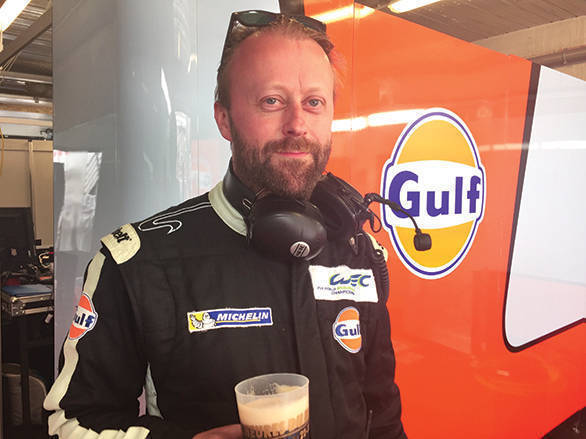 Owen Daley enjoys a much needed cold one after his team finished fifth in class at the 2016 24 Hours of Le Mans
Owen Daley enjoys a much needed cold one after his team finished fifth in class at the 2016 24 Hours of Le Mans
I watched as fans flocked onto the circuit to get as close to the podium as possible. I watched as tired and defeated drivers walked back into their garages. I watched as Porsche, Toyota and Audi drivers all managed to make it to the podium in the LMP1 class of the event. And I watched as trophies were taken away after the podium ceremony in the GTE Pro class a terrible business of appeals and counter appeals about the rightful race winner. And within the Gulf Racing UK pits, I watched a very tired Owen Daley sip a cold one, and pensively say, "It's a lot harder than it looks " of his team's fifth-in-class finish in the GTE Am class. It wasn't outright jubilation that I saw in that particular garage. It was more relief mingled with fatigue. Their first-ever 24 Hours of Le Mans was over at long last.
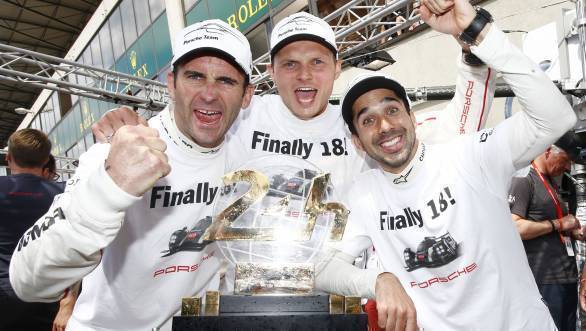 Finally 18! The T-shirt really says it all!
Finally 18! The T-shirt really says it all!
As I was walking back from the pits, I passed the No.6 Toyota that eventually finished second parked alongside the third-placed Audi. The cars had come to a halt, but the people hadn't. There was plenty to do. In some parts of the track, it was celebration. In other parts of the track, it was the mundane packing of cars, spares and people. And it was the sheer disparity of it all that stood out. That's really what struck me the most at the 2016 edition of the 24 Hours of Le Mans. The sheer contrast that the race brings out. You can see this contrast in the haves and have-nots. You can see this contrast in the highs and lows, in the joyful celebration and the bitter defeat, and in the trophies won and battles lost. It's a whole spectrum of human emotion put under a magnifying glass over the course of a weekend. It's what makes Le Mans so scarily real.
Starts Rs 1.38 Crore
2998cc
Automatic
350
530
-NA-

